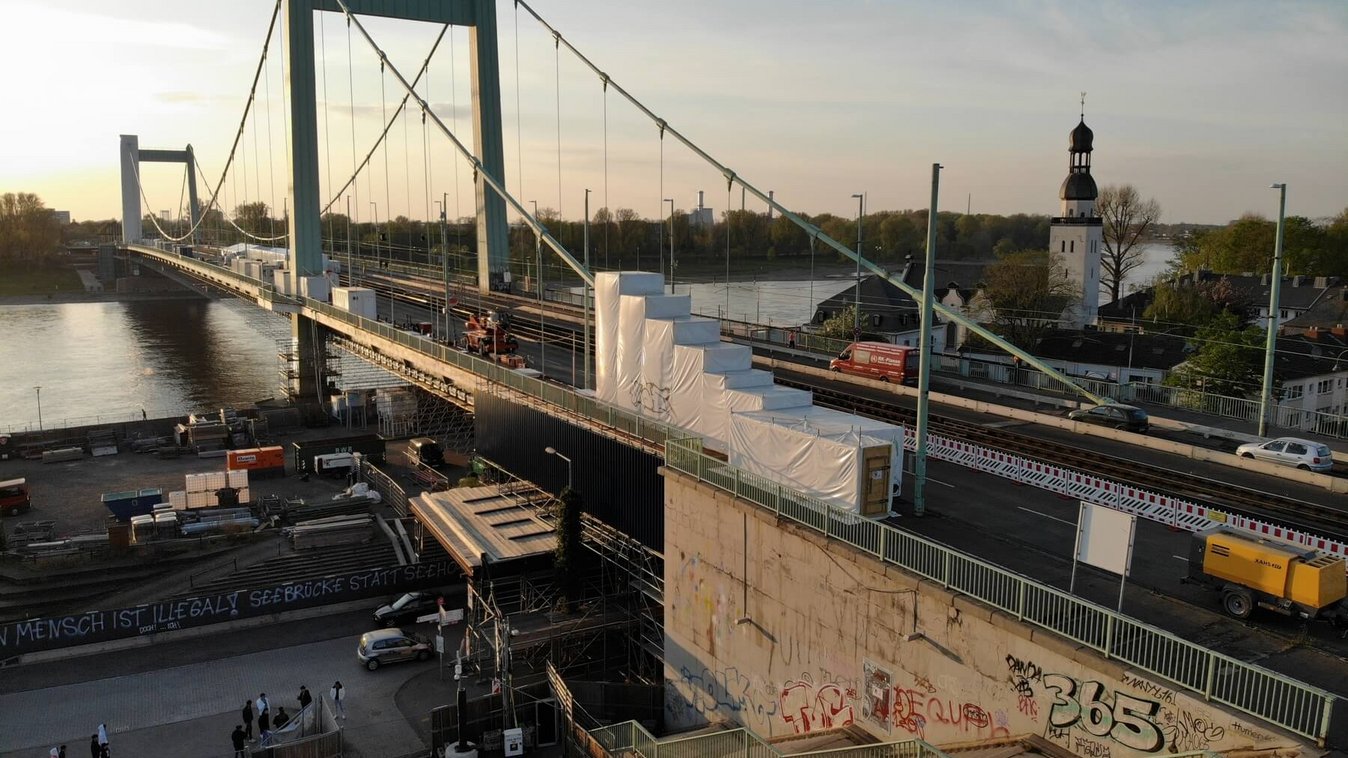
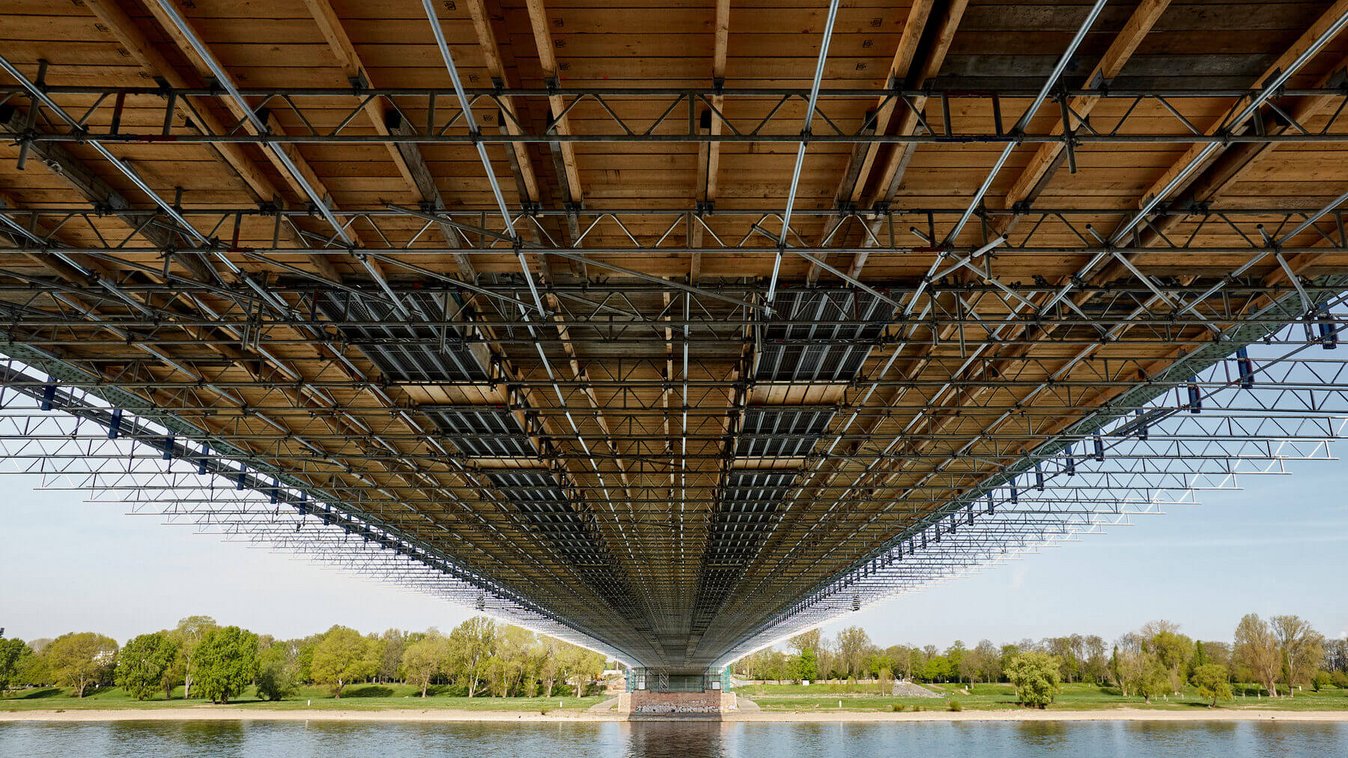
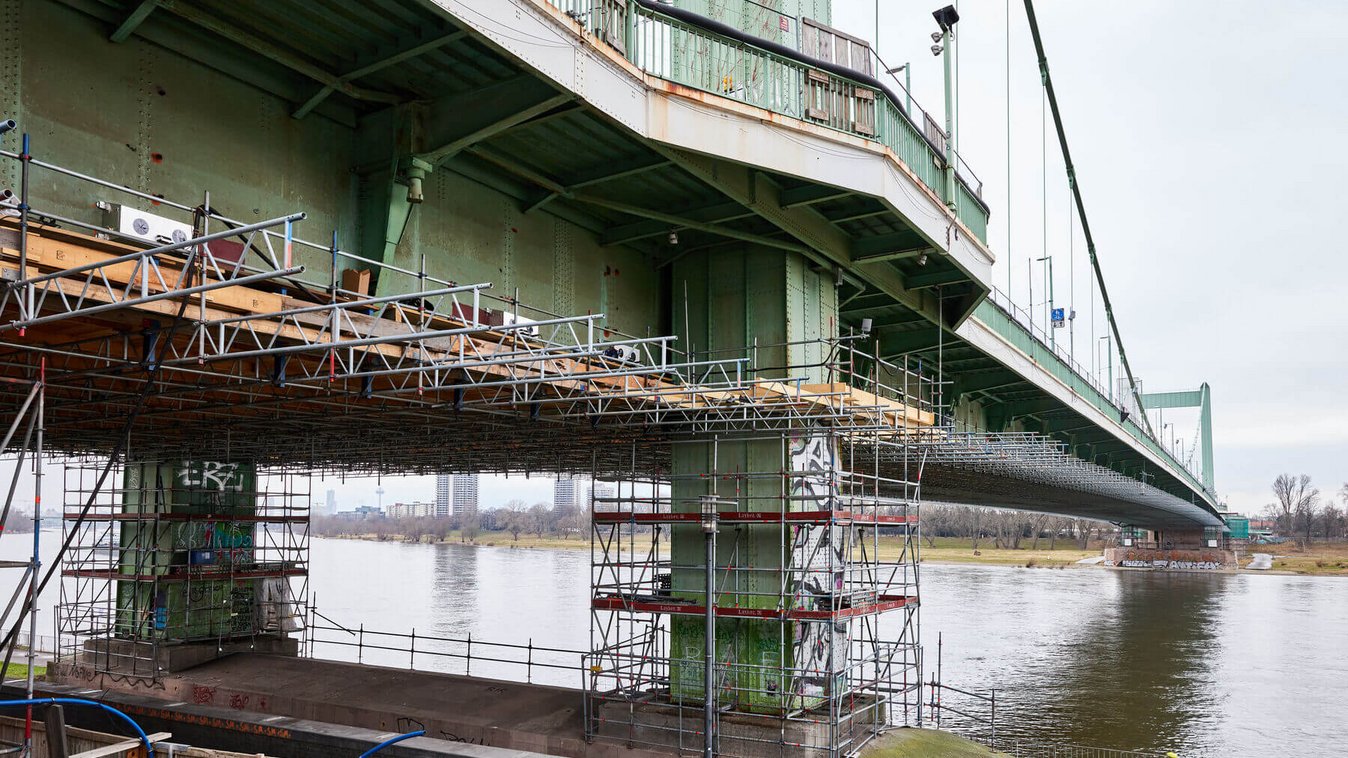
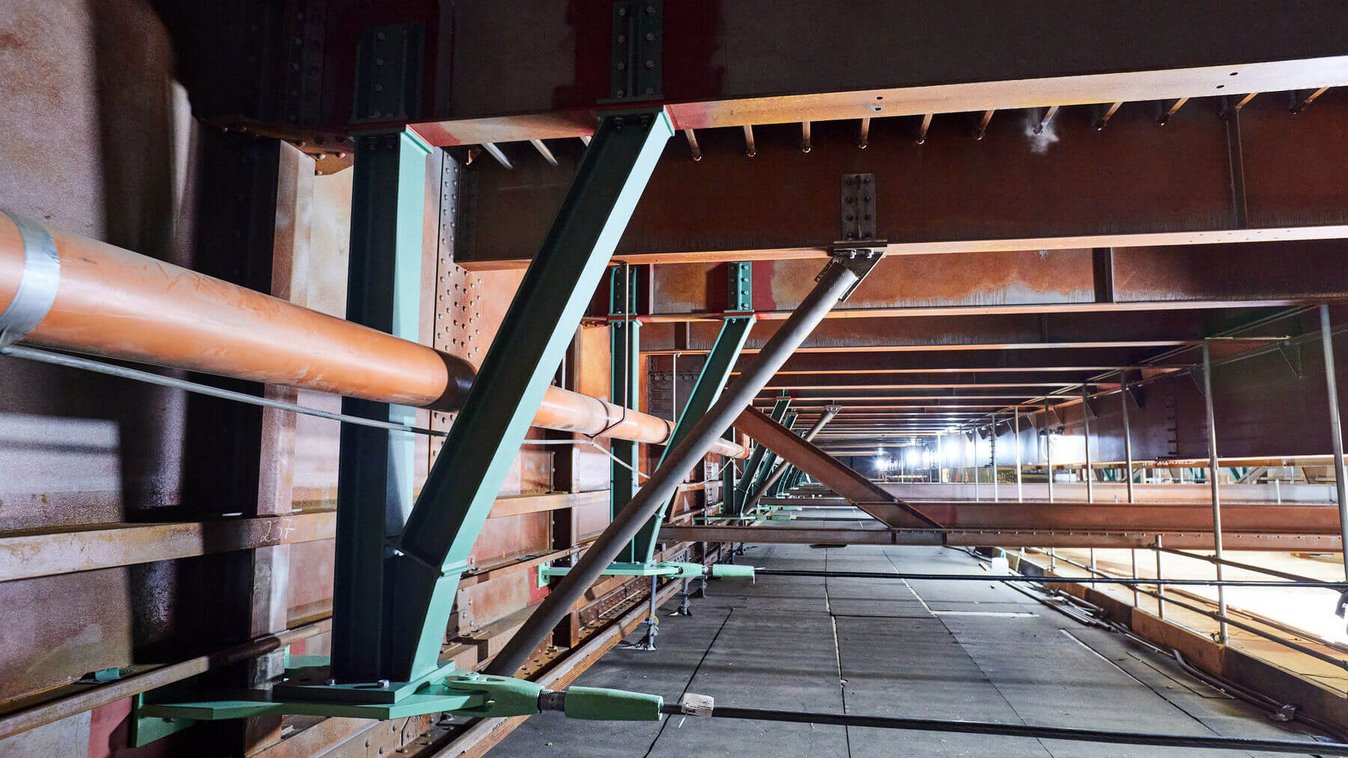
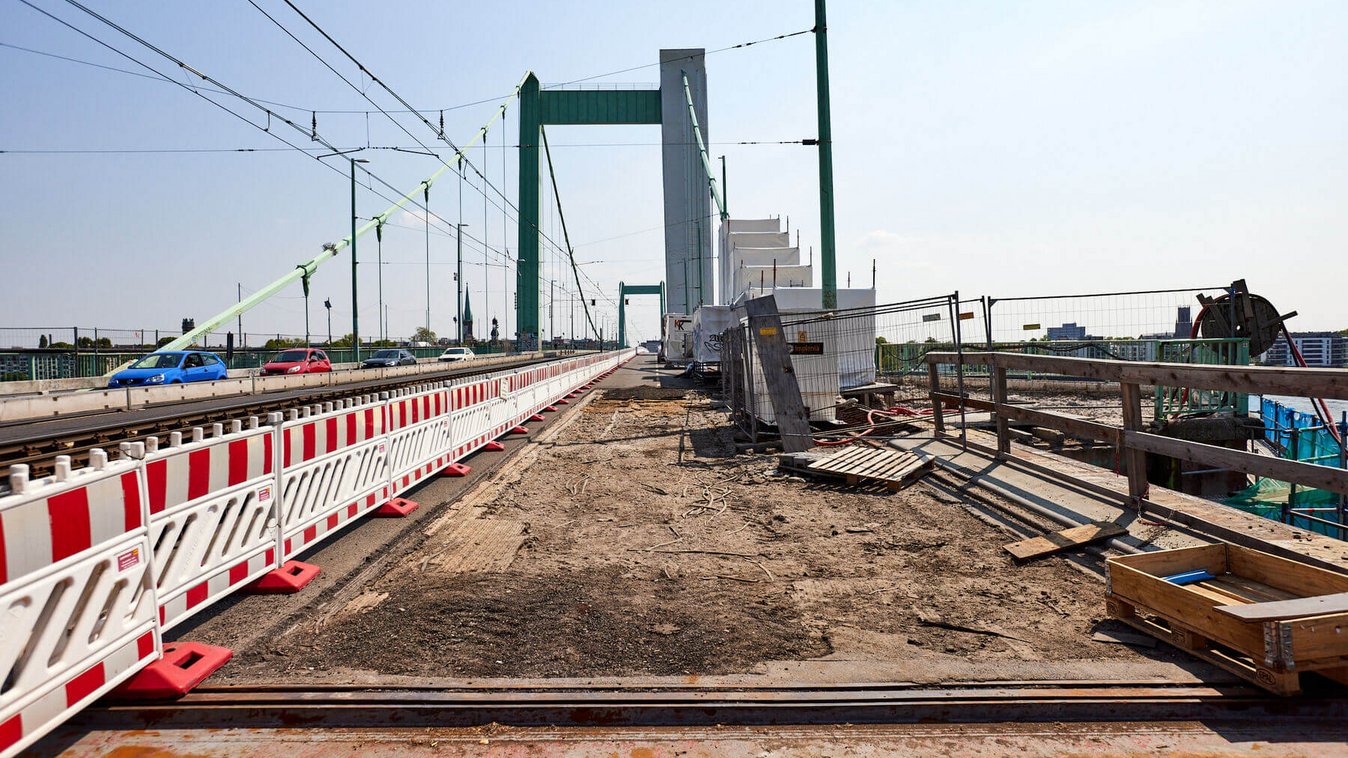
Gesamtinstandsetzung Mülheimer Brücke, Köln
Short description
Repair of a steel cable suspension bridge over the Rhine, demolition and new construction of the ramp structures on both sides of the Rhine, in several traffic phases while maintaining traffic (MIV, IV, public transport).
The project
The Mülheim Bridge carries the B51 federal highway including lateral sidewalks and cycle paths as well as the KVB light rail lines over the Rhine and connects the Cologne districts of Riehl and Mülheim. The entire bridge has a length of approx. 950m and consists of the following seven substructures (enumeration from the left bank of the Rhine to the right bank of the Rhine), which are essentially similar in terms of the road cross-section, but differ significantly in terms of their construction:
- Dike bridge as a four-span steel bridge, superstructure steel girder grid, approx. 94m long
- Separating piers incl. staircase made of reinforced concrete
- Flood bridge as two-span steel structure, approx. 116m long
- Left or right Rhine anchor pier as end support of the river bridge to absorb the anchoring forces from the supporting cable
- River bridge as suspension bridge with longitudinal, transverse and load distribution girders made of steel with two parallel supporting cables over the Rhine, approx. 485m long
- Ramp on the right bank of the Rhine as a 248m-long frame structure with three overpass structures in reinforced concrete construction with a 127m-long retaining structure attached to it.
The Mülheim Bridge was originally built between 1927 and 1929, but was destroyed by an air raid on October 14, 1944. The reconstruction of the river bridge over the Rhine took place in the years 1949-1951 as a new building. The remaining partial structures were also badly damaged during the war, but were preserved and put back into operation after the structure was repaired and strengthened. These are thus now almost 100 years old.
Today's traffic bottleneck ensures the connection of the city center with adjacent industrial sites (e.g. Niehler Hafen, Ford and Bayer plants), various highway connections (e.g. A1, A3, A4) and is used for the city's two streetcar lines. In the course of structural inspections, numerous damages to the bridge structures were found. The maintenance of the traffic as well as additionally the adjacent new construction of the Leverkusen highway bridge of the A1 and the highly frequented shipping lane argued against a complete demolition with subsequent new construction of the listed bridge train.
Instead, the planned overall rehabilitation envisages permanently restricted maintenance of public transport (MIV, IV, ÖPNV) for the entire construction period.
Services in detail
- In general: The work will be carried out in stages and in 3 parts over the bridge cross-section, in which two of the three traffic axes (2x MIV + 1x streetcar) will be maintained over the entire length of the bridge. Construction clearance will be provided in the closed third for demolition and new construction or rehabilitation.
- Dyke Bridge: Complete replacement of the structure using hollow boxes as composite bridge structure, deep foundations of the new reinforced concrete piers and abutments using micropiles.
- Separating pier: Repair of the reinforced concrete separation pier with replacement of the stairways.
- Flood bridge: Repair of the existing steel bridge structure, renewal of the cantilever section, complete renewal of the corrosion protection, strengthening/reinforcement of the longitudinal stiffeners on the main girders, replacement of the steel deck plate structure including rail structure
- Anchor piers: Repair of the left- and right-bank reinforced concrete anchor pier, renewal of the deck slab
- Strombrücke: Strengthening of the steel superstructure by installation of new cross girder reinforcements by means of tension band as well as truss longitudinal girders and replacement of all suspension cables, extension of the cantilever arms in the area of the pylons as well as repair of the bridge structure, here also complete renewal of the corrosion protection
- Ramp on the right bank of the Rhine: two-story reinforced concrete frame structure replaced in stages and in 3 sections by a new replacement structure, the retaining wall areas to the east are being rehabilitated, all deep foundations are being made using micropiles and in some areas also large bore piles.
- Use of BIM methods for project management.
Challenges
The inner-city construction work will be carried out under traffic during almost the entire construction period, with only one lane being closed in each direction. The new construction or repair of the middle section of the light rail bridge must be carried out during a short 19-week closure period, for which rail replacement services will be provided. This results in unavoidable general conditions for traffic routing, construction site equipment and the construction sequence.
The significantly deteriorated condition of the existing structure of the 1929 ramp on the right bank of the Rhine, which was discovered after the start of the project, necessitated extensive analyses of the building materials and a complete reassessment of the load-bearing capacity. As an immediate measure, traffic had to be reduced to a maximum permissible total weight of 3.5 tons. As a result, the client's execution planning had to be extensively rescheduled with regard to the building aids (structural condition) and the deep foundation (brown coal layer). The construction of the modified design could therefore not begin until the end of 2020.
In the area of the Strombrücke, the dilapidated condition of the existing structure was also investigated in more detail, the result of which has so far been a redesign of the cross girder reinforcement, a partial new construction of the deck plate and an additional investigation of the suspension cable and suspension cable clamps. An analogous condition assessment of the steel superstructure of the adjacent flood bridge also requires a partial reconstruction of the deck plate.
In the course of dismantling the two ramp structures and in the pylons of the river bridge, a large number of asbestos-contaminated components were found, the removal of which led to changes in the construction sequence. In addition, numerous hazardous materials with appreciable pollutant contents had to be removed. For the handling and disposal of these contaminated and hazardous materials, appropriate protective measures are required during removal (setting up black/white areas, working under full protection), transport, interim storage and disposal.
Construction in existing buildings remains a major and demanding challenge. An extension of the construction period of an additional forecast approx. 4 years currently illustrates the special requirements.
Sustainability
- The client has established an ecological construction supervision. In cooperation and coordination with the ecological construction supervision, far-reaching measures for the protection of flora and fauna are implemented.
Further information
Site Management / Site Supervision Zetcon Ingenieure GmbH
